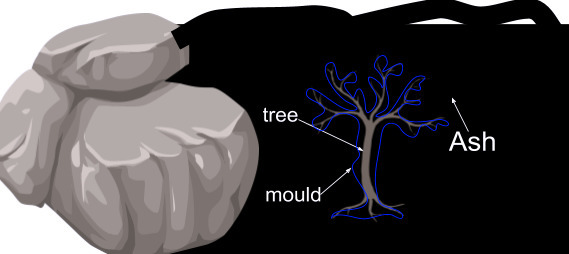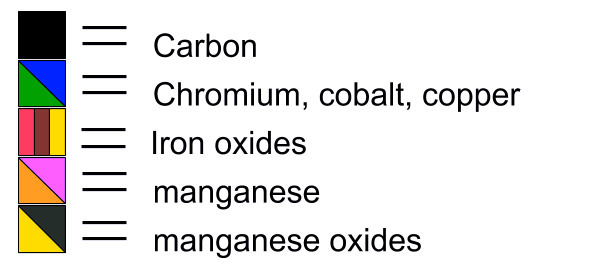*Be sure to check out the Traditional cache located right next to this one: (GC2AZNA) OCBSA Cache to Eagle #12 (ENC)
This Earthcache was hidden with special permission from the Environmental nature center. An Earthcache is a virtual cache that teaches about a special geoscience feature of the Earth. To successfully complete this Earthcache, you must go inside their visitor's center. See their schedule below. The center will have to be open during one of the hours below to complete this Earthcache.

The Environmental Nature Center teaches the community about environmental conservation ♻️. Their goal is to "Provid[e] quality education through hands-on experience with nature." In addition to a nature center, Their location includes, an outdoor auditorium, hiking trails, various plants and animals, and even a butterfly room.
Monday-Friday: 8am-5pm Saturday: 8am-4pm
To complete the Earthcache, you will have to read the information below carefully. DO NOT SKIP TO THE LOGGING REQUIREMENTS!
Background: Petrified Tree:
Petrified Wood:
Petrified comes from the Greek root "Petro" meaning stone, or rock. "Petrified" is the name given to a very unique type of tree.A fossilized tree. A petrified tree is a fossilized tree's remains. More in-depth, a terrestrial vegetation's remains. Terrestrial Vegetation, is simply a plant that grows and lives on land. Petrified trees are completely turned into minerals. In-side out! How could such process occur?
Petrifaction process:
Fossils are mostly found under ground. Petrified Terrestrial Vegetation (trees) are not to disappoint. After a tree, or at least it's wood" gets buried under ground, the process begins. The lack of oxygen that occurs since the tree is buried, starts decomposition. Mineral-laden water then puts minerals into the plant cells in the tree, forming a mold when the actual tree decomposes.

Perminalization:
Perminzalization is responasible for most fossilization. During this process, mineral is deposited into existing living cells, causing the makeup of the "victim" to be fossilized. There are different forms and types, but the one responsible for petrified trees is Silification. Silification, is when rocks weather into silica, (A type of fine sand like mineral found in quartz, based of different chemical makeups and other minerals) and then find their way into water, then spreads through into the cells of a dead organism, where is becomes a gel-like makeup. Over time, the gel dehydrates and hardens around the organism creating a crystal structure in replace of the organism.
More information:
The petrifying process lasts millions of years. This being, it is very rare to have a chunk of a petrified tree, much less a whole one. But, in Arizona there is a whole petrified forest! It is an official national park. More on this here.

An example of a sliced, polished petrified tree.
About this Tree:
As stated before, this tree is very rare. It is almost in whole, so make sure to take a picture! Most petrified trees are in chunks, or pieces. So, even though there rare, I'm sure you've been to a museum or place sometime, somewhere and seen one of these beauties.
This tree was donated by Robert House, the founder of the ENC, Somewhere in the 1970s-1980s, when the nature center was being created. Mr. House wanted to create a place where the community could learn, about conserving nature. Robert wanted to simply teach. He knew that Most Science and Biology teachers wanted to learn nature, but somewhere else from a textbook in the classroom. He wanted them to learn in "The real world." So, little by little The ENC developed. If you look around, and explore this center, you will see many rare plant specimens. This is an intention to keep all of them thriving. One of these rare plant specimens is, of course, the tree. Although there is no exact number, this tree is about just over 200 million years old. Since, as stated, Mr. House wanted the ENC to be "an outdoor classroom," he sees this tree, along with all of the other trees, logs, bugs, animals, and shrubs, as a learning opportunity, for all ages, genders, and races. I at least hope you at least learned a little by the time you finish this Earthcache, but I have a little inkling you will.
To complete this Earthcache, you will have to send me a message through the geocaching message center containing your answer to eah of these questions. I am really "grading" you based off of #5. Really take time to learn and study the table!!
Logging Requirements:
1. This cache's name
2. Your username, and any others in your group.
3. Lightly feel the tree. What is it's texture? Hard? Smooth? Bumpy? You decide!
4. Which set of the 3 words/phrases best describe the tree?
a. Mineral, Geological, Fossil
b. Wooden, Coal, Hardy
c. Colorful, geographical, shiny
5. Use the table below. The table has elements and their corresponding colors. Name all of the minerals that the tree can possibly consists of based on the mineral's colors.


View Ratings for GC7WQMM

Congrats to FTF by Ckm8dude!!!🎉
